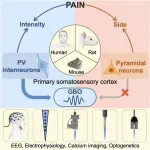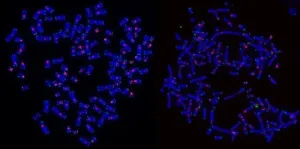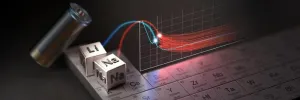How does the brain encode pain? Scientists uncover neuronal mechanisms of pain intensity encoding
2025-01-13
(Press-News.org)
A research team led by Prof. HU Li at the Institute of Psychology of the Chinese Academy of Sciences, has revealed that parvalbumin (PV) interneurons in the primary somatosensory cortex (S1) preferentially encode pain intensity and drive nociceptive-evoked gamma oscillations (GBOs).
Published online in Neuron on January 13, the study fills a longstanding gap in understanding the origins of nociceptive-evoked GBOs and their selective relationship with pain processing across different species.
The findings suggest the potential for using these oscillations as a promising target for therapeutic interventions.
Pain is a major source of human suffering, resulting in economic costs amounting to hundreds of billions of dollars annually. Accurate assessment and effective treatment of pain are critical yet challenging due to the inherently subjective nature of pain. As a result, researchers have engaged in intense efforts to identify selective neural biomarkers for pain perception.
Previous studies have established that nociceptive-evoked GBOs faithfully encode pain and pain-related behaviors in both humans and animals, suggesting their potential as neural biomarkers.
However, the neuronal mechanisms underlying GBOs have remained poorly understood, limiting the use of GBOs in clinical applications.
To address this problem, Prof. HU and his colleagues conducted a series of cross-species experiments. The experiments featured both nociceptive and non-nociceptive sensory stimuli, a range of neural recording techniques (high-density EEG in humans; and silicon probes and calcium imaging in rodents), and optogenetic methods (both alone and simultaneous with electrophysiology in mice).
Their results confirmed that GBOs in S1 selectively encode pain intensity in humans and are closely linked to spiking activity of PV-positive interneurons in rodents. Calcium imaging indicated that PV interneurons, rather than pyramidal cells, preferentially track pain intensity. Follow-up optogenetic manipulations demonstrated that activating or inhibiting PV interneurons could alter nociceptive-evoked GBOs and related pain-related behaviors.
By linking PV interneuron activity at the microscopic level to GBOs at the mesoscopic level, this research firmly establishes PV interneurons in S1 as the neuronal basis for GBOs’ role in encoding pain intensity.
“These findings are not only significant for understanding the physiology of cortical nociceptive processing but also have far-reaching implications as GBOs are increasingly recognized as a pain biomarker in clinical practice and drug development,” says Prof. HU Li, corresponding author of the study.
END
[Attachments] See images for this press release:

ELSE PRESS RELEASES FROM THIS DATE:
2025-01-13
INDIANAPOLIS – Due to the physical contact nature of their occupation, the elite athletes of the National Football League (NFL) often experience pain. However, an analysis of 2021 and 2022 data from the National Football League Prescription Drug Monitoring Program shows that team members in those two years were even less likely than both the general U.S. population and males of similar age living in the U.S., to have a prescription for an opioid pain medication.
The study found that less than 3 percent of pain medications prescribed to the athletes who played in one or both of the two seasons were for opioids. Slightly more than 86 percent of the ...
2025-01-13
The mosquito-borne Zika virus is known for causing microcephaly, a birth defect in which abnormal brain development results in a smaller-than-expected head. A new study published Jan. 13 in mBio shows that the Zika virus hijacks a host protein called ANKLE2, which happens to be important for brain development, to assist its own reproduction. Because Zika, unlike most related viruses, can cross the placenta, this can have disastrous consequences in pregnancy.
“It’s a case of Zika being in the wrong place at the wrong time,” said Priya Shah, associate professor in the departments of Microbiology and Molecular ...
2025-01-13
The concentration of the population in cities is accelerating, and difficulties in maintaining various infrastructures are arising due to extreme weather. Extensive infrastructures like waste landfill facilities face significant challenges due to the difficulty for managers to stay on-site or access them. These maintenance issues are resulting in various problems, including environmental pollution.
To solve these issues, Korea Institute of Civil Engineering and Building Technology (KICT, President Sun Kyu, Park) has developed a cost-effective and high-efficiency maintenance technology using satellite ...
2025-01-13
This work reveals a new mechanism by which brown fat is converted into heat, and which protects from pathologies associated with obesity.
The MCJ protein is key to the fat burning mechanism now identified, making it a promising target for treating obesity, according to the authors in Nature Communications.
The research is led by Guadalupe Sabio, from Spain’s National Cancer Research Centre (CNIO), and Cintia Folgueira, from both CNIO and the National Centre for Cardiovascular Research (CNIC).
Obesity, which affects 650 ...
2025-01-13
‘True Food’ Research Database Offers Rankings for 50,000 Processed Foods
The database, developed by researchers at Mass General Brigham and made available to the public, sheds light on the availability of processed foods at different grocery stores, highlighting the need for more understanding and regulation of the foods offered
A new study by investigators from Mass General Brigham provides information to empower consumers and policymakers about the degree of processing of the foods available at three large grocery retailers. Using an algorithm, the researchers analyzed ...
2025-01-13
Scientists at Children’s Medical Research Institute (CMRI) have solved a big mystery in cancer research – why cells die in different ways following radiotherapy. This surprising finding opens up new opportunities to improve treatment and increase cure rates.
The findings were published in Nature Cell Biology by first author Dr Radoslaw Szmyd of CMRI’s Genome Integrity Unit, which is led by Professor Tony Cesare.
Radiation therapy (also called radiotherapy) is a critically important type of cancer treatment. Scientists have struggled for decades to understand why radiation therapy kills cells from the ...
2025-01-13
The most detailed study to date on the mechanisms by which a common type of bacterium, Staphylococcus aureus, adapts to living on the human body could help improve the prevention, diagnosis, and treatment of certain infections.
The study, from the Wellcome Sanger Institute, the University of Cambridge, the Institute of Biomedicine of Valencia (IBV) at the Spanish National Research Council (CSIC) and their collaborators, involved using the genomes of thousands of S. aureus isolates cultured from the human nose and on the skin to investigate which genes are important for the bacteria to adapt and persist.
Published today (13 January) in Nature Communications, ...
2025-01-13
Legions of battery engineers and their supporters have sought for years to build batteries cheaper than the dominant lithium-ion technology, hoping to capture some of lithium-ion’s $50 billion-a-year and growing market. The latest darling contender among researchers, startups, and venture capitalists – sodium-ion batteries – has received much attention after COVID-induced mineral supply chain challenges sent lithium prices on a wild ride. Still, achieving a low-cost contender may be several years away for sodium-ion batteries and will require a set of technology advances and favorable ...
2025-01-13
Scientists from the Francis Crick Institute, UCL, UCLH and Personalis have found that a test to detect circulating tumour DNA can predict lung cancer outcome in a Cancer Research UK-funded study.
Circulating tumour DNA (ctDNA) is fragments of DNA released into the blood by tumours. It’s known to be important for disease prognosis but can be difficult to measure precisely.
In research published today in Nature Medicine, Crick and UCL scientists worked with Personalis to test a platform called NeXT Personal, which can detect very small amounts – 1 part per million – ...
2025-01-13
Scientists have come a step closer to understanding how collisionless shock waves – found throughout the universe – are able to accelerate particles to extreme speeds.
These shock waves are one of nature's most powerful particle accelerators and have long intrigued scientists for the role they play in producing cosmic rays – high-energy particles that travel across vast distances in space.
The research, published today in Nature Communications, combines satellite observations from NASA’s MMS (Magnetospheric Multiscale) and THEMIS/ARTEMIS missions with recent theoretical advancements, offering a comprehensive new model ...
LAST 30 PRESS RELEASES:
[Press-News.org] How does the brain encode pain? Scientists uncover neuronal mechanisms of pain intensity encoding






